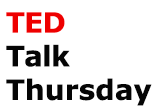by atmara | Jul 12, 2012 | Healing, TED Talks, Video

According to ted.com: “Poet, writer, activist Eve Ensler lived in her head. In this powerful talk from TEDWomen, she talks about her lifelong disconnection from her body — and how two shocking events helped her to connect with the reality, the physicality of being human.”
“Inspired by intimate conversations with friends, Eve Ensler wrote The Vagina Monologues. The play recounts tender, funny, gripping and horrifying stories she gathered from hundreds of women about their bodies, their sexual experiences, and yes, their vaginas. Since its first staging in 1996, it has been translated into more than 45 languages, performed in more than 120 countries and re-created as an HBO film.”
“The Vagina Monologues‘ success allowed Ensler to create V-Day, a global activist movement to end violence against women and girls, which has so far raised $85 million to prevent violence and protect abused women. In February 2011, Ensler received the Isabelle Stephenson Tony Award for her philanthropic work. Ensler has also drawn praise for The Good Body, a play that cuts to women’s obsession with their appearance, and her film What I Want My Words to Do to You, which portrays a writing group she leads at a correctional facility for women. Today, she continues to find new projects and push the envelope. Her latest play, I Am an Emotional Creature: The Secret Life of Girls Around the World, hit the New York Timesbestseller list and just wrapped a workshop production in Johannesburg — nest stop is Paris and then Berkeley in June 2012.”
This is a powerful talk.
For those of you not familiar with TED Talks here is a brief summery from www.ted.com:
“TED is a small nonprofit devoted to Ideas Worth Spreading. It started out (in 1984) as a conference bringing together people from three worlds: Technology, Entertainment, Design. Since then its scope has become ever broader. Along with two annual conferences — the TED Conference in Long Beach and Palm Springs each spring, and the TEDGlobal conference in Oxford UK each summer — TED includes the award-winning TEDTalks video site, the Open Translation Project and Open TV Project, the inspiring TED Fellows and TEDx programs, and the annual TED Prize”
——————————————————————————————————–
I look forward to your thoughts and comments!
Be sure to Subscribe to this blog either by RSS or Email via the forms on the top right column of the page.
Like this:
Like Loading...
by atmara | May 24, 2012 | Art, Healing, Inspiration, Mandalas, TED Talks, Video

According to ted.com: “Buddhist roshi Joan Halifax works with people at the last stage of life (in hospice and on death row). She shares what she’s learned about compassion in the face of death and dying, and a deep insight into the nature of empathy.”
“Activist, anthropologist, author, caregiver, ecologist, LSD researcher, teacher, and Zen Buddhism priest — Joan Halifax is many things to many people. Yet they all seem to agree that no matter what role she plays, Halifax is consistently courageous and compassionate. Halifax runs the Upaya Zen Center in New Mexico, a Zen Peacemaker community she opened in 1990 after founding and leading the Ojai Foundation in California for ten years. Her practice focuses on socially engaged Buddhism, which aims to alleviate suffering through meditation, interfaith cooperation, and social service.”
“As director of the Project on Being With Dying, Halifax has helped caregivers cope with death and dying for more than three decades. Her book Being With Dying helps clergy, community activists, medical professionals, social workers and spiritual seekers remove fear from the end of life. Halifax is a distinguished invited scholar of the U.S. Library of Congress and the only woman and Buddhist on the Tony Blair Foundation’s Advisory Council.”
I hope you find her talk inspiring.
For those of you not familiar with TED Talks here is a brief summery from www.ted.com:
“TED is a small nonprofit devoted to Ideas Worth Spreading. It started out (in 1984) as a conference bringing together people from three worlds: Technology, Entertainment, Design. Since then its scope has become ever broader. Along with two annual conferences — the TED Conference in Long Beach and Palm Springs each spring, and the TEDGlobal conference in Oxford UK each summer — TED includes the award-winning TEDTalks video site, the Open Translation Project and Open TV Project, the inspiring TED Fellows and TEDx programs, and the annual TED Prize”
——————————————————————————————————–
I look forward to your thoughts and comments!
Be sure to Subscribe to this blog either by RSS or Email via the forms on the top right column of the page.
Like this:
Like Loading...
by atmara | Mar 5, 2012 | Art, Healing, Mandala Monday, Mandalas
Author: Paulo Boranti
Like the rest of the global village, Indians also experience anger, that raw, powerful emotion that seems to take over our lives, consuming our thoughts.
Indian people use an art therapy technique, drawing ‘mandalas’, to help calm and express their rage in a careful and controlled way.
Mandala, is the Sanskrit word for ‘circle’. Within this circle the Indians say there are no rules, a space in which you alone exist. A place where you can let your feelings come out as a swirl of colours and lines.
The Times of India recently featured an article on how this process works.
How Mandalas Work
Participants find that once they finish drawing an angry mandala, they are tempted to draw a new, happy one, since their anger has been released through artistic expression. If you suffer from anger management issues, perhaps you should give it a try.
Participants like Manju Mohinani says:
“You get lost with the colors and the movement of your hands and thus you express yourself clearly without even realizing it. The best part is that when you do mandalas you are not thinking, you get so lost in the drawing. You don’t feel that you are working on yourself, its so easy and so much fun.’
Manju is a real advocate of drawing mandalas – it’s the way she as dealt with her anger for years, stating that she just takes out paper and crayons and lets go. Once the drawing is complete, she feel at peace with herself again.

Manju Mohinani
Drawing Materials is All That’s Needed
Drawing a mandala is very simple. All you need is a sheet of paper and a box of crayons or coloured pencils, the kind used in schools by children is fine. Mandalas are not an art, so you do not need to worry about how they look or whether you are doing them right or wrong. You’re not trying to create a masterpiece, the point of the drawing is to express how you feel.
Manju says:
‘to sketch an anger mandala , just sit and feel your anger. When you feel, it clearly takes up the colour that fits the best. Then draw a circle on the paper and let the feelings emerge on their own. Let them get expressed inside the circle, using whatever lines or colors that come. Don’t censor yourself and don’t think, just let go.’
Participants find drawing mandalas is something that is easy to do, and is a novel way of revealing your true feelings, break down some boundaries and show that you are in control. And of course, if you are in control, you can take steps to solve the problem that was causing the anger.
The Benefits of Drawing Mandalas and What They Might Mean
The primary reason for drawing a mandala is to be an outlet for anger, but sometimes people see a certain significance in what they have drawn.
If you do give mandalas a try, have a look to see if your drawings are full of ‘fighting spirit’, passion and frustration shown by heavy, jagged, red lines? Are the drawings made up of more gentle, softer colored, curved lines, showing you are more depressed and apathetic about your situation?
Red, brown or black are the typical colors for angry mandalas. The shapes and their position are also quite indicative of inner feelings. The overlapping shapes and black crosses and show a lot of anger. Anger spills over when your drawing extends beyond the confines of the circle.
Mandalas provide a way of dealing with turbulent events in our lives, providing an almost childlike way to express yourself and have fun. You might find that the drawing helps you understand a little bit more about the cause of your anger.
While there are plenty of other therapies, none are quite as much fun as mandalas .Using a crayon to scribble on a simple piece of plain paper takes us back to those carefree childhood days. It’s a satisfying and fun therapy. And remember, you do not have to understand your drawings, just the process of drawing the mandala is enough to relieve the burden of anger.
So, the next time you find yourself getting wound up, instead of grumbling and grizzling for weeks, just grab some colored pencils or crayons, place out a sheet of paper and let go. You will not only deal with your anger, but have a wonderful time doing it as well. And the best part, you will relish every moment.
Article Source: http://www.articlesbase.com/stress-management-articles/indians-use-art-therapy-to-reduce-anger-877125.html
About the Author:
Paulo Boranti has recently published his guide to job seeking, Job Hunting – Getting the Job You Deserve. Paulo is a motivational coach, who has run his own freelance consultancy practice for many year, and now passes on his knowledge online. Paulo also writes an interviews and jobs blog.
——————————————————————————————————–
I look forward to your thoughts and comments!
Be sure to Subscribe to this blog either by RSS or Email via the forms on the top right column of the page.
Like this:
Like Loading...


